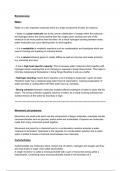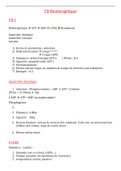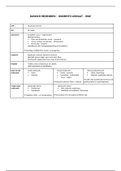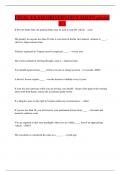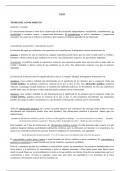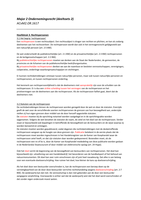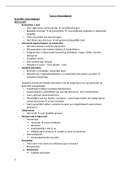Biomolecules:
Water:
Water is a very important molecule which is a major component of cells, for instance:
• Water is a polar molecule due to the uneven distribution of charge within the molecule –
the hydrogen atoms are more positive than the oxygen atom causing one end of the
molecule to be more positive than the other. As a result hydrogen bonding between many
water molecules can occur allowing them to stick together.
• It is a metabolite in metabolic reactions such as condensation and hydrolysis which are
used in forming and breaking of chemical bonds.
• It is a solvent allowing gases to readily diffuse as well as enzymes and waste products
e.g. ammonia and urea.
• It has a high heat specific capacity. This is because water molecules stick together with
hydrogen bonds meaning that a lot of energy is required to break these bonds. This helps to
minimise temperature fluctuations in living things therefore it acts as a buffer.
• Hydrogen bonding means that it requires a lot of energy to evaporate 1 gram of water.
Therefore water has a relatively large latent heat of vaporisation, meaning evaporation of
water provides a cooling effect with little water loss e.g. sweating.
• Strong cohesion between molecules enables effective transport of water in tubes like the
xylem. The strong cohesion supports columns of water, as a result of strong cohesion the
surface tension at the water-air boundary is high.
<<<<<<<<<<<<<<<<<<<<<<<<<<<<<<<<<<<<<<<<<<<<<<<<<<<<<<<<<<<<<<<<<<<<<<
Monomers and polymers:
Monomers are small units which are the components of larger molecules, examples include
monosaccharides such as glucose, amino acids and nucleotides. Polymers are molecules
made from many monomers joined together.
Monomers are joined by a chemical bond in a condensation reaction whereby a water
molecule is eliminated. Hydrolysis is the opposite of a condensation reaction and is when
water is added to break a chemical bond between two molecules.
Carbohydrates:
Carbohydrates are molecules which consist only of carbon, hydrogen and oxygen and they
are long chains of sugar units called saccharides.
A single monomer is called a monosaccharide with a pair of monomers being called a
disaccharide. Combining many monosaccharides results in the formation of a
, polysaccharide. These are all joined together with a glycosidic bond formed in a
condensation reaction.
Monosaccharides:
Glucose is a monosaccharide containing six carbon atoms in each molecule, and is the main
substrate for respiration and therefore of great importance. It has two isomers – alpha and
beta glucose with structures being seen on the right.
Common monosaccharides include glucose, galactose and fructose. These are typically
sweet tasting, soluble substances which have the general formula (CH2O)n where n can be
any number from three to seven.
Disaccharides:
Two monosaccharides can join together in a condensation reaction to form a disaccharide.
In this process a molecule of water is produced. The diagram below shows the formation of
a 1,4 glycosidic bond between two alpha glucose molecules in order to form a molecule of
maltose.
Examples of some common disaccharides and how they are formed are shown below:
• Maltose is a disaccharide formed by condensation of two glucose molecules.
• Sucrose is a disaccharide formed by condensation of glucose and fructose.
• Lactose is a disaccharide formed by condensation of glucose and galactose.
Polysaccharides:
Polysaccharides are formed from many glucose units joined together and include:
• Glycogen and starch which are both formed by the condensation of alpha glucose.
• Cellulose formed by the condensation of beta glucose.
Glycogen is the main energy storage molecule in animals and is formed from many
molecules of alpha glucose joined together by 1, 4 and 1, 6 glycosidic bonds.
It has a large number of side branches meaning that energy can be released quickly as
enzymes can act simultaneously on these branches.
Moreover, it is a relatively large but compact molecule thus maximising the amount of energy
it can store. Finally being insoluble means it will not affect the water potential of cells and
cannot diffuse out of cells.
Water:
Water is a very important molecule which is a major component of cells, for instance:
• Water is a polar molecule due to the uneven distribution of charge within the molecule –
the hydrogen atoms are more positive than the oxygen atom causing one end of the
molecule to be more positive than the other. As a result hydrogen bonding between many
water molecules can occur allowing them to stick together.
• It is a metabolite in metabolic reactions such as condensation and hydrolysis which are
used in forming and breaking of chemical bonds.
• It is a solvent allowing gases to readily diffuse as well as enzymes and waste products
e.g. ammonia and urea.
• It has a high heat specific capacity. This is because water molecules stick together with
hydrogen bonds meaning that a lot of energy is required to break these bonds. This helps to
minimise temperature fluctuations in living things therefore it acts as a buffer.
• Hydrogen bonding means that it requires a lot of energy to evaporate 1 gram of water.
Therefore water has a relatively large latent heat of vaporisation, meaning evaporation of
water provides a cooling effect with little water loss e.g. sweating.
• Strong cohesion between molecules enables effective transport of water in tubes like the
xylem. The strong cohesion supports columns of water, as a result of strong cohesion the
surface tension at the water-air boundary is high.
<<<<<<<<<<<<<<<<<<<<<<<<<<<<<<<<<<<<<<<<<<<<<<<<<<<<<<<<<<<<<<<<<<<<<<
Monomers and polymers:
Monomers are small units which are the components of larger molecules, examples include
monosaccharides such as glucose, amino acids and nucleotides. Polymers are molecules
made from many monomers joined together.
Monomers are joined by a chemical bond in a condensation reaction whereby a water
molecule is eliminated. Hydrolysis is the opposite of a condensation reaction and is when
water is added to break a chemical bond between two molecules.
Carbohydrates:
Carbohydrates are molecules which consist only of carbon, hydrogen and oxygen and they
are long chains of sugar units called saccharides.
A single monomer is called a monosaccharide with a pair of monomers being called a
disaccharide. Combining many monosaccharides results in the formation of a
, polysaccharide. These are all joined together with a glycosidic bond formed in a
condensation reaction.
Monosaccharides:
Glucose is a monosaccharide containing six carbon atoms in each molecule, and is the main
substrate for respiration and therefore of great importance. It has two isomers – alpha and
beta glucose with structures being seen on the right.
Common monosaccharides include glucose, galactose and fructose. These are typically
sweet tasting, soluble substances which have the general formula (CH2O)n where n can be
any number from three to seven.
Disaccharides:
Two monosaccharides can join together in a condensation reaction to form a disaccharide.
In this process a molecule of water is produced. The diagram below shows the formation of
a 1,4 glycosidic bond between two alpha glucose molecules in order to form a molecule of
maltose.
Examples of some common disaccharides and how they are formed are shown below:
• Maltose is a disaccharide formed by condensation of two glucose molecules.
• Sucrose is a disaccharide formed by condensation of glucose and fructose.
• Lactose is a disaccharide formed by condensation of glucose and galactose.
Polysaccharides:
Polysaccharides are formed from many glucose units joined together and include:
• Glycogen and starch which are both formed by the condensation of alpha glucose.
• Cellulose formed by the condensation of beta glucose.
Glycogen is the main energy storage molecule in animals and is formed from many
molecules of alpha glucose joined together by 1, 4 and 1, 6 glycosidic bonds.
It has a large number of side branches meaning that energy can be released quickly as
enzymes can act simultaneously on these branches.
Moreover, it is a relatively large but compact molecule thus maximising the amount of energy
it can store. Finally being insoluble means it will not affect the water potential of cells and
cannot diffuse out of cells.

